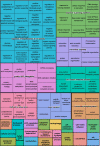Genetic diversity and connectivity of chemosynthetic cold seep mussels from the U.S. Atlantic margin
- PMID: 35715723
- PMCID: PMC9204967
- DOI: 10.1186/s12862-022-02027-4
Genetic diversity and connectivity of chemosynthetic cold seep mussels from the U.S. Atlantic margin
Abstract
Background: Deep-sea mussels in the subfamily Bathymodiolinae have unique adaptations to colonize hydrothermal-vent and cold-seep environments throughout the world ocean. These invertebrates function as important ecosystem engineers, creating heterogeneous habitat and promoting biodiversity in the deep sea. Despite their ecological significance, efforts to assess the diversity and connectivity of this group are extremely limited. Here, we present the first genomic-scale diversity assessments of the recently discovered bathymodioline cold-seep communities along the U.S. Atlantic margin, dominated by Gigantidas childressi and Bathymodiolus heckerae.
Results: A Restriction-site Associated DNA Sequencing (RADSeq) approach was used on 177 bathymodiolines to examine genetic diversity and population structure within and between seep sites. Assessments of genetic differentiation using single-nucleotide polymorphism (SNP) data revealed high gene flow among sites, with the shallower and more northern sites serving as source populations for deeper occurring G. childressi. No evidence was found for genetic diversification across depth in G. childressi, likely due to their high dispersal capabilities. Kinship analyses indicated a high degree of relatedness among individuals, and at least 10-20% of local recruits within a particular site. We also discovered candidate adaptive loci in G. childressi and B. heckerae that suggest differences in developmental processes and depth-related and metabolic adaptations to chemosynthetic environments.
Conclusions: These results highlight putative source communities for an important ecosystem engineer in the deep sea that may be considered in future conservation efforts. Our results also provide clues into species-specific adaptations that enable survival and potential speciation within chemosynthetic ecosystems.
Keywords: Adaptation; Bathymodioline; Bathymodiolus heckerae; Chemosynthetic; Genomics; Gigantidas childressi; RADseq; Recruitment; SNP.
© 2022. The Author(s).
Conflict of interest statement
The authors declare that they have no competing interests.
Figures






Similar articles
-
Molecular characterization of Bathymodiolus mussels and gill symbionts associated with chemosynthetic habitats from the U.S. Atlantic margin.PLoS One. 2019 Mar 14;14(3):e0211616. doi: 10.1371/journal.pone.0211616. eCollection 2019. PLoS One. 2019. PMID: 30870419 Free PMC article.
-
New geochemical tools for investigating resource and energy functions at deep-sea cold seeps using amino acid δ15 N in chemosymbiotic mussels (Bathymodiolus childressi).Geobiology. 2021 Nov;19(6):601-617. doi: 10.1111/gbi.12458. Epub 2021 Jun 18. Geobiology. 2021. PMID: 34143929
-
Parasitism in species of Bathymodiolus (Bivalvia: Mytilidae) mussels from deep-sea seep and hydrothermal vents.Dis Aquat Organ. 2004 Nov 23;62(1-2):1-16. doi: 10.3354/dao062001. Dis Aquat Organ. 2004. PMID: 15648826
-
Temporal change in deep-sea benthic ecosystems: a review of the evidence from recent time-series studies.Adv Mar Biol. 2010;58:1-95. doi: 10.1016/B978-0-12-381015-1.00001-0. Adv Mar Biol. 2010. PMID: 20959156 Review.
-
Symbioses between deep-sea mussels (Mytilidae: Bathymodiolinae) and chemosynthetic bacteria: diversity, function and evolution.C R Biol. 2009 Feb-Mar;332(2-3):298-310. doi: 10.1016/j.crvi.2008.08.003. Epub 2008 Nov 25. C R Biol. 2009. PMID: 19281960 Review.
Cited by
-
Population genomics and connectivity of Vazella pourtalesii sponge grounds of the northwest Atlantic with conservation implications of deep sea vulnerable marine ecosystems.Sci Rep. 2025 Jan 9;15(1):1540. doi: 10.1038/s41598-024-82462-z. Sci Rep. 2025. PMID: 39788986 Free PMC article.
-
Population structure and adaptability analysis of Schizothorax o'connori based on whole-genome resequencing.BMC Genomics. 2024 Feb 6;25(1):145. doi: 10.1186/s12864-024-09975-9. BMC Genomics. 2024. PMID: 38321406 Free PMC article.
References
-
- Sibuet M, Olu K. Biogeography, biodiversity and fluid dependence of deep-sea cold-seep communities at active and passive margins. Deep Sea Res Part II. 1998;45(1–3):517–567.
-
- Jones WJ, Won YJ, Maas PAY, Smith PJ, Lutz RA, Vrijenhoek RC. Evolution of habitat use by deep-sea mussels. Mar Biol. 2006;148(4):841–851.
-
- Van Dover CL, Aharon P, Bernhard JM, Caylor E, Doerries M, Flickinger W, et al. Blake Ridge methane seeps: characterization of a soft-sediment, chemosynthetically based ecosystem. Deep Sea Res Part I. 2003;50(2):281–300.
-
- Duperron S, Guezi H, Gaudron SM, Pop Ristova P, Wenzhöfer F, Boetius A. Relative abundances of methane-and sulphur-oxidising symbionts in the gills of a cold seep mussel and link to their potential energy sources. Geobiology. 2011;9(6):481–491. - PubMed
-
- Cordes EE, Becker EL, Hourdez S, Fisher CR. Influence of foundation species, depth, and location on diversity and community composition at Gulf of Mexico lower-slope cold seeps. Deep Sea Res Part II. 2010;57(21–23):1870–1881.
Publication types
MeSH terms
LinkOut - more resources
Full Text Sources
